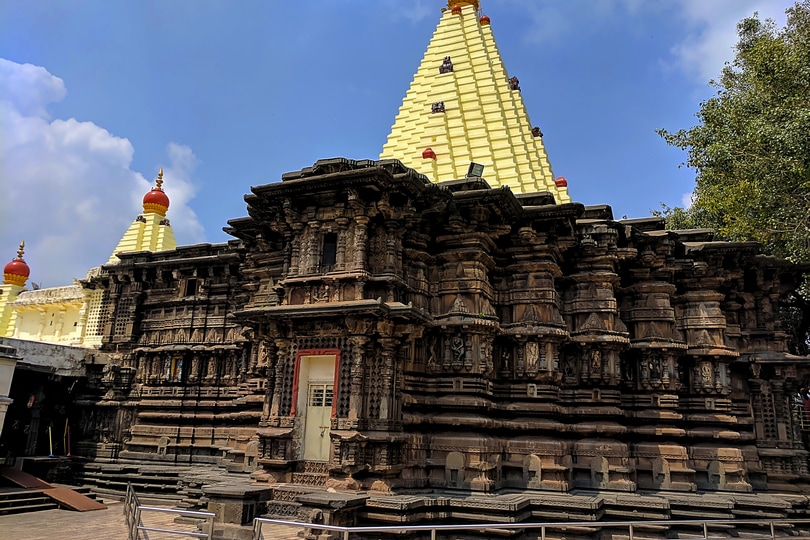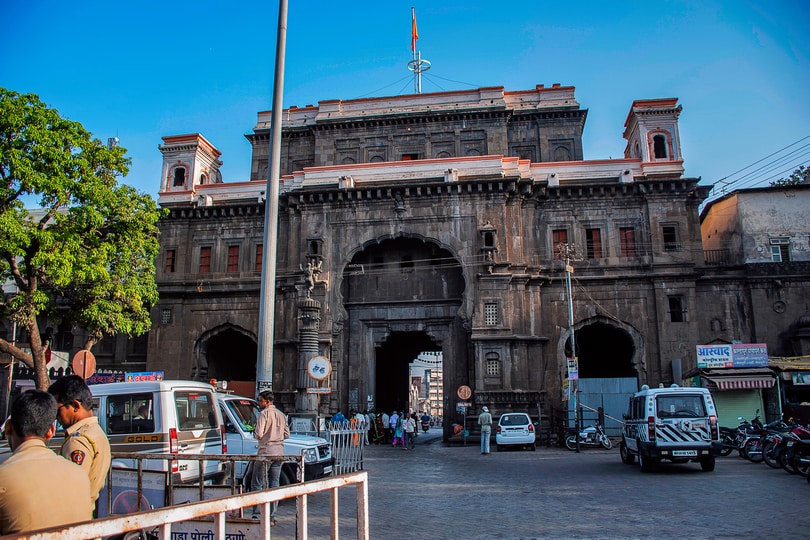Rightly called as ‘the sugar bowl of India’, Kolhapur can be aptly described as a perfect blend of natural beauty and history. It also acts as a crucial business center for manufacturing commodities like Kolhapuri Necklaces and Kolhapuri Leather Slippers. Apart from that, if you are a food lover, this town of Kolhapur will not disappoint you as it offers some of the most sumptuous dishes prepared with local spices and vegetables.
Kolhapur, having a rich and sound backdrop, is now one of the most developed cities of Maharashtra. It is also amongst the famous tourist destinations of kolhapur. The city has a multitude of noteworthy places to see, which include Holy places, palaces and forts, museums and wildlife sanctuaries. It is now recognized as a vital spiritual center as it houses a significant number of temples from Medieval India.
Jyotiba Temple was founded in the turn of the 17-century by the then ruler, Ranoji Shinde. It lies at a high altitude of about 3200-feet above sea levels. Lord Jyotiba, who is the prime deity worshipped in this magnificent temple, is believed to be an incarnation of Lord Shiva. Lord Jyotiba is basically an amalgamation of the three souls or jyotis of – Lord Brahma, Lord Vishnu, and Lord Mahesha.
Time and again, color has been a vital aspect of this temple. You will generally find the exteriors of the temple color clad most of the time. This is primarily due to the fact that gulal (pink coloured sacred powder) is offered to Lord Jyotiba as a token of devotion by the pilgrims. To reach up to the temple, you will have to climb a long flight of at least 100 stairs. An array of shops selling religious offerings line the entire route. The interiors of the temple are quite elegant and have incredible architectural facets.
During the Hindu months of Chaitra and Vaishakha, a special Sunday ritual for the devotees is staged in this religious site. Partake in the annual fairs that are scheduled in these months, when the entire temple is decorated to celebrate the holy period. You will see how worshippers throng the temple carrying tall ‘sasans’ or sticks and chanting ‘Jyotibachya Navane Changbhala’. They smear ‘gulal’ on each other’s foreheads, which in turn transforms the whole vicinity into a flamboyant field of hues.

Dedicated to the Hindu deity Amba Devi, Mahalakshmi Temple stands as a crucial symbol of Hindu faith and religion. It was constructed in the 7-century under the reign of Chalukyas. Deemed as one of the Shakti Peethas of the country, it is enlisted in various puranas of Hinduism under the name of Dakshin Kashi. The temple takes its name from Mahalakshmi, the consort of Vishnu, and it is believed that the divine couple resides in the area, still.
The crown of the deity consists of an image of the Sheshnag — the serpent of Vishnu. In four of Her hands, she holds objects of symbolic value – a mhalunga (a citrus fruit) in the left hand, a large mace (kaumodaki) in the upper right hand with its head touching the ground, in the upper left a shield (khetaka), and in the lower left, a bowl (panpatra).
Surprisingly, unlike most Hindu sacred idols, which face north or east, the idol of this deity faces west (Pashchim). There is a small window on the western wall, through which the rays of the sunset falls on the face of the idol for three days around the 21st of each March and September, without fail! This is a temple that gives insight into the historical heritage of the city and hence, should not be missed on the trip to this town.
Nrusinhawadi is a popular religious site in Kolhapur district. It is best known for being the capital of Datta devotees. Situated on the sacred confluence of Rivers Krishna and Panchganga, it has a massive importance in the episodes of Maharashtrian history.
According to legend, this temple was built by a Muslim King, Adil Shah of Bijapur district. Apparently, his daughter had lost her eyes, for which he was suggested to go visit Nrusinhawadi. He worshipped the principles of his Guru with utmost sincerity and then applied the sacred ash given by him on his daughter’s eyes. She, fortunately, regained vision. As a token of appreciation, he dedicated two whole villages named Ourwad and Gourwad on the other side of River Krishna to Nrusinhawadi.
The temple also has its own share of exceptional architectural details. The devotee hall has a silver metal lining on its face portion and at the center, there is a charming illustration made of peacock feathers. Images of Nrusinhawadi are carved in here with an elaborate silver metal cover. There is also a large circular Mandap in the central courtyard with large columns where worshippers can come any time to recite or chant prayers. This is a pure example of a place where tranquillity and serenity abounds.

A court, in the beginning, a palace in the recent yesteryears to now a public monument, Bhawani Mandap is a unique religious site in the city of Kolhapur.
The building is placed in close proximity to the famous Mahalaxmi Temple that has been mentioned earlier, within the walled precincts of this city. Although it is a bit smaller in size than the Mahalaxmi Temple yet the pious significance of this Mandap is immense. It is said to be dedicated to Goddess Tulja Bhavani, who happens to be the elder sister of Goddess Mahalakshmi.
Bhavani Mandap used to be an important meeting venue in yesteryears. On special request, one can see a modest wooden throne, which is believed to have been used by Shivaji Maharaj on his visits to Kolhapur. This emphasized the fact that the great Maratha warrior king was more of a man on a mission with little regard for pomp and conceit.
The architecture of the Mandap is inspired by British contemporary influence. It has an old-world charm with a life-size statue of Kolhapur’s most beloved King Shahu Maharaj gracing the Bhavani Mandap. One of the most remarkable features of this Mandap is the distinctive display of stuffed animals such as bison, panthers, and a pair of deer that were actually hunted by Shahu Maharaj himself, bringing alive memories of the rich princely state Kolhapur used to be then.
There is also a widespread rumour among the locals that an underground tunnel leading to Bhavani Mandap from Panhala (the hillside for about 20 kilometers away from Kolhapur) was built to allow an escape route for the warring Maratha soldiers. However, if the hearsay is true, the tunnel is yet to be discovered.
One can see a mammoth idol of Lord Bahubali, on a hilltop in the resplendent city of Kolhapur. This temple is also enshrined with other deities such as Lord Bahubali, Lord Shantinath, Lord Chandaprabhu, and Lord Adinath Digambar. Installed in the year 1963, you can see Lord Bahubali in a standing position, for that you may have to take the staircase of 70 steps in order to view the deity.
As per mythology, an ascetic saint Shri Bahubali Maharaj resided here almost 350 years ago. He was a renowned scholar and a mystic. People still believe that due to his spiritual presence no wild animals would attack the pilgrims visiting the temple site. The site has been named Kumbhoj Bahubali in order to commemorate the virtues of this great saint. After the sad demise of the saint Bahubali, many great spiritual Jain Munis have visited the place converting this temple site even blessed for the devout followers of Jainism.
You can also find many Jain temples alongside – after coming down on the right side you have Mahaveer Digmabar Jain ‘Jal Mandir’ temple and on the left, you have ‘Ratnatrya’ Digambar Jain temple. Classes take place all year-round in the Swadhyay Bhavan where more than one thousand students study in the Gurukul under Bahubali University.
The ancient Kopeshwar Temple at Khidrapur in Kolhapur District is dedicated to Lord Shiva and rests on the bank of River Krishna. There are reasons to believe that even though the construction of Kopeshwar Temple started sometime in the 7-century AD, the work remained incomplete largely due to constant skirmishes between warring rulers of the region. The renovation was completed only in the 12-century by the Shilahara and the Yadava Kings.
This temple is bifurcated into four parts, all interconnected through vestibules. The first structure you would enter through is the Swarga Mandap (Heavenly Hall). The architecture of Swarga Mandap is unbelievable and seems surreal, portraying a feeling of heaven. This Mandap is circular and curvy in shape and is constructed with the support of 48 well carved rounded stone pillars, which are placed in three circles. Each of these 48 pillars has been specifically carved in different shapes -round, square, hexagon, and octagon. Yet another interesting feature of the Swarga Mandap is that a part of the circular ceiling in the middle (with a radius of 13-feet) is left open to the sky. The sanctum is conical. The exterior too has fascinating carvings of deities and secular figures.
The Shivaling is facing north and both lings are found in the same sanctum sanctorum. Another notable feature of this temple is that there is no Nandi at the entrance, which is a regular feature for almost all Shiva temples. The mythology behind these characteristics makes for an appealing explanation.
According to legend, it is believed that Daksha, who did not like the decision of his youngest daughter Sati marrying Lord Shiva, conducted a Yagna to which he did not invite the couple. On knowing this, Sati visited her father’s house on Shiva’s Nandi to confront her father. Dakhsa insulted her in front of the guests present at the Yagna. She was not able to bear any further insults and jumped in the fire of Yagna and immolated herself. When Lord Shiva came to know about the incident, he was infuriated. He punished Daksha by severing his head. Lord Vishnu soothed Shiva where he restored Daksha’s head but with a goat’s head. The furious Shiva was brought to Khidrapur Temple by Lord Vishnu to pacify him down. And that explains how the temple got its unusual name as Kopeshwar (wrathful god).
The Kopeshwar Temple is a must-see on the tourist itinerary for its ancient and artistic sculpture. This is a busy temple, which witnesses loads of worshippers on Mondays and Shivratri nights.
So now that you have a fair enough idea on the many exquisite religious sites in Kolhapur, what are you waiting for? Dive right into a sea of spirituality, away from the shackles of a monotonous life. Book your tickets now. Let Kolhapur welcome you with all that it has.
Happy Journey!

Please go back to portrait mode for the best experience